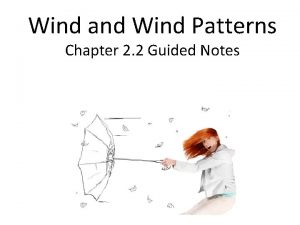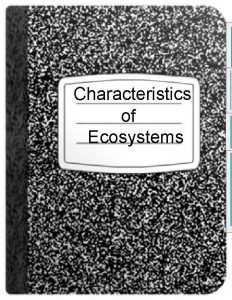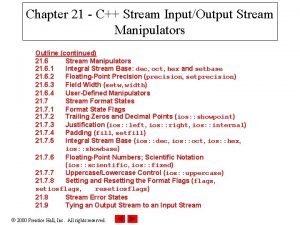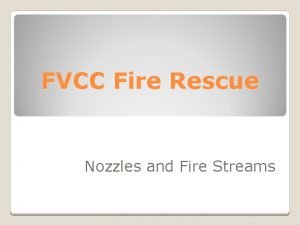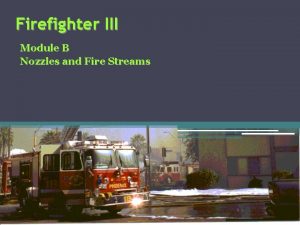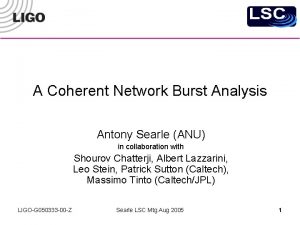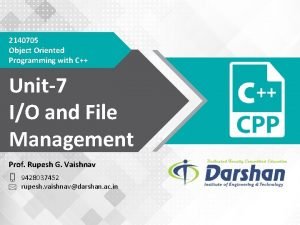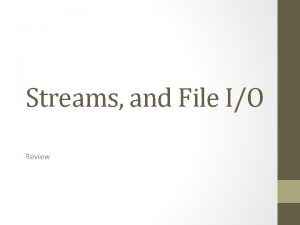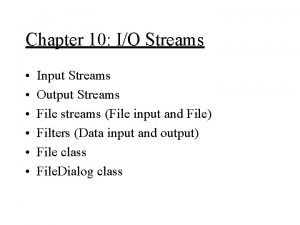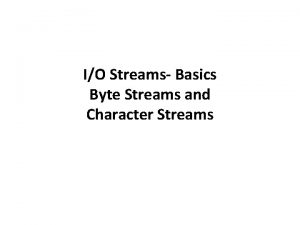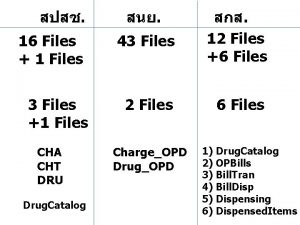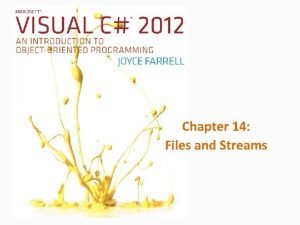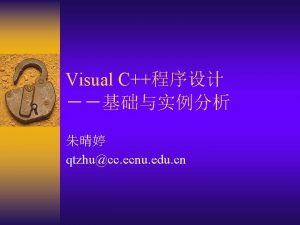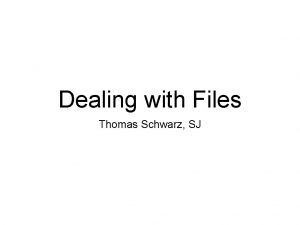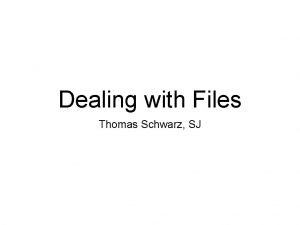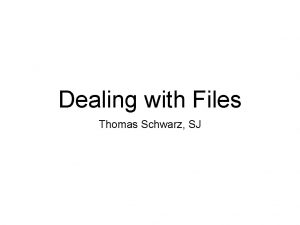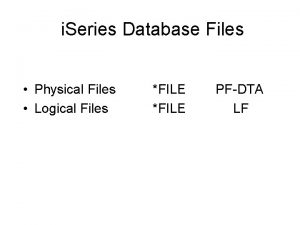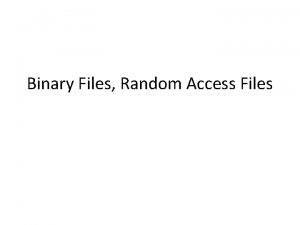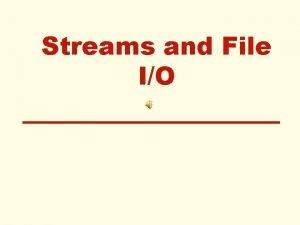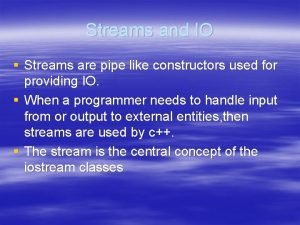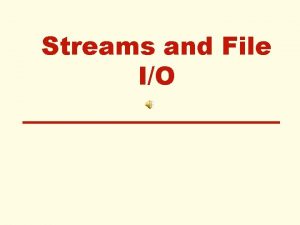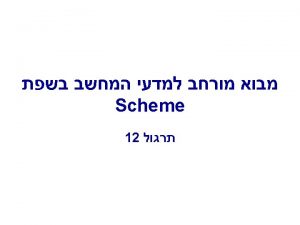Files Streams Files Introduction Files are used for





















- Slides: 21

Files & Streams

Files Introduction Files are used for long-term retention of large amounts of data, even after the program that created the data terminates. Data maintained in files often is called persistent data. The smallest data item that computers support is called a bit (short for “binary digit”—a digit that can assume one of two values). Digits, letters and special symbols are referred to as characters. Bytes are composed of eight bits. C# uses the Unicode® character set (www. unicode. org) in which characters are composed of 2 bytes. Just as characters are composed of bits, fields are composed of characters. A field is a group of characters that conveys meaning. Typically, a record is composed of several related fields. A file is a group of related records. To facilitate the retrieval of specific records from a file, at least one field in each record is chosen as a record key, which uniquely identifies a record. A common file organization is called a sequential file, in which records typically are stored in order by a record-key field.

Data

Files and Streams C# views each file as a sequential stream of bytes When a console application executes, the runtime environment creates the Console. Out, Console. In and Console. Error streams. Console. In refers to the standard input stream object, which enables a program to input data from the keyboard. Console. Out refers to the standard output stream object, which enables a program to output data to the screen. Console. Error refers to the standard error stream object, which enables a program to output error messages to the screen. Console methods Write and Write. Line use Console. Out to perform output Console methods Read and Read. Line use Console. In to perform input.

System. IO The System. IO namespace includes stream classes such as Stream. Reader, Stream. Writer and File. Stream for file input and output. These stream classes inherit from abstract classes Text. Reader, Text. Writer and Stream, respectively. Abstract class Stream provides functionality for representing streams as bytes. Classes File. Stream , Memory. Stream and Buffered. Stream (all from namespace System. IO) inherit from class Stream. Class File. Stream can be used to write data to and read data from files.

Class File’s static methods for manipulating and determining information about files:

Class File’s static methods

Class Directory provides capabilities for manipulating directories.

Class Directory • The Directory. Info object returned by method Create. Directory contains information about a directory.

File. Form. Test example Let’s look at an example to get information about files and directories, list files in a directory or display contents of a file. The Stream. Reader constructor takes as an argument a string containing the name of the file to open. Stream. Reader method Read. To. End read the entire contents of the file as a string. Call Directory method Get. Directories to obtain an array of subdirectories in the specified directory.

Records C# imposes no structure on files. Thus, the concept of a “record” does not exist in C# files. Our examples will have a bank account as a record. The record contains Account number, First and Last Names and the Balance of the account. See Record. cs

Common Input UI: Bank. UIForm

Create an Output File Let’s look at our example of writing accounts into a file. Create. File. Form solution. Create. File. Form inherits from Bank. UIForm Create. File. Form uses instances of class Record to create a sequential-access file.

Create. File. Form Class Save. File. Dialog is used for selecting files. The constant File. Mode. Open. Or. Create indicates that the File. Stream should open the file if it exists or create the file if it does not. To preserve the original contents of a file, use File. Mode. Append. The constant File. Access. Write indicates that the program can perform only write operations with the File. Stream object. There are two other File. Access constants—File. Access. Read for read-only access and File. Access. Read. Write for both read and write access. An IOException is thrown if there is a problem opening the file or creating the Stream. Writer method Write. Line writes a sequence of characters to a file. The Stream. Writer object is constructed with a File. Stream argument that specifies the file to which the Stream. Writer will output text. Method Close throws an IOException if the file or stream cannot be closed properly.

Reading Files Now we’re going to read records from the file created by the Create. File. Form program, then display the contents of each record. Solution: Read. Sequential. Access. File. Form

Read. Sequential. Access. File. Form Open. File. Dialog is used to open a file. The behavior and GUI for the Save and Open dialog types are identical, except that Save is replaced by Open. Specify read-only access to a file by passing constant File. Access. Read as the third argument to the File. Stream constructor. Stream. Reader method Read. Line reads the next line from the file.

File Position • A File. Stream object can reposition its file-position pointer to any position in the file. • When a File. Stream object is opened, its file-position pointer is set to byte position 0. • You can use Stream. Reader property Base. Stream to invoke the Seek method of the underlying File. Stream to reset the file-position pointer back to the beginning of the file. • Exercise: Add a Start/Beginning button to the Read. Sequential. Access. File. Form program to go to the very first record.

Serialization Sometimes it is easier to read or write entire objects than to read and write individual fields. C# provides such a mechanism, called object serialization. A serialized object is an object represented as a sequence of bytes that includes the object’s data, its type and the types of data stored in the object. After a serialized object has been written to a file, it can be read from the file and deserialized.

Serialization Class Binary. Formatter enables entire objects to be written to or read from a stream. Binary. Formatter method Serialize writes an object’s representation to a file. Binary. Formatter method Deserialize reads this representation from a file and reconstructs the original object. Both methods throw a Serialization. Exception if an error occurs during serialization or deserialization. Example: Serialization solution

Serialization (writing to a file) • Method Serialize takes the File. Stream object as the first argument so that the Binary. Formatter can write its second argument to the correct file. • Remember that we are now using binary files, which are not human readable.

Deserialization (reading from a file) Example: Deserialization solution • Deserialize returns a reference of type object. • If an error occurs during deserialization, a Serialization. Exception is thrown.
 Insidan region jh
Insidan region jh Dot powai files are binary files
Dot powai files are binary files Cjis security policy
Cjis security policy Ncic hosts restricted files and non-restricted files
Ncic hosts restricted files and non-restricted files Types of jet streams
Types of jet streams Bill nye rivers and streams
Bill nye rivers and streams Cost streams
Cost streams Oracle streams
Oracle streams Ainkholes
Ainkholes Yakshi holding a fly whisk
Yakshi holding a fly whisk In the desert, ephemeral streams _____.
In the desert, ephemeral streams _____. Setfill
Setfill Data nugget streams as sensors answers
Data nugget streams as sensors answers Broken stream nozzle
Broken stream nozzle Illustrate the proper handling of fire streams
Illustrate the proper handling of fire streams Oracle streams
Oracle streams Basic concepts in mining data streams
Basic concepts in mining data streams A framework for clustering evolving data streams
A framework for clustering evolving data streams Antony searle
Antony searle 2140705
2140705 Different bodys of water
Different bodys of water Lisp lazy evaluation
Lisp lazy evaluation




